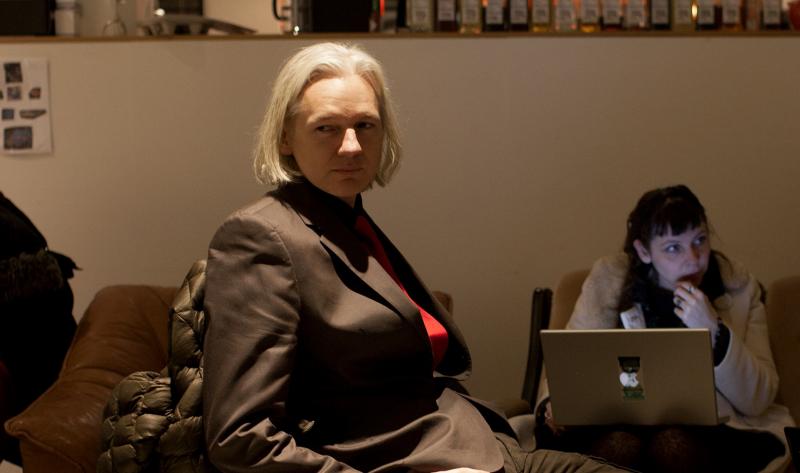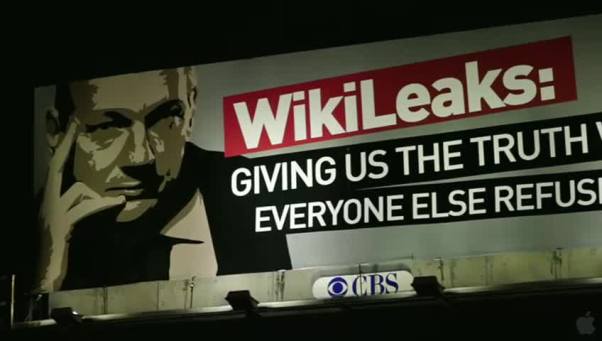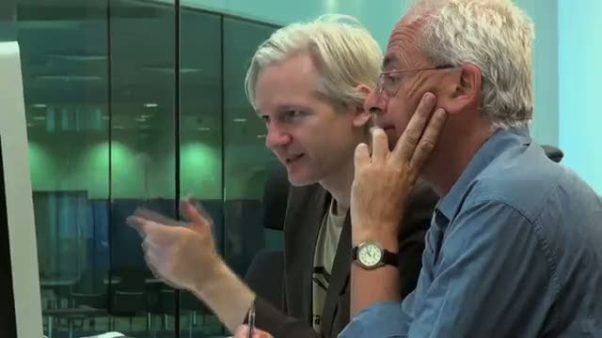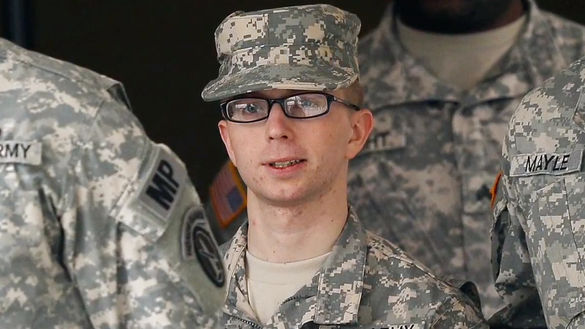We Steal Secrets: The Story of WikiLeaks | reviews, news & interviews
We Steal Secrets: The Story of WikiLeaks
We Steal Secrets: The Story of WikiLeaks
Heroism and self-destruction collide in a revealing look at Julian Assange

The story you think you know slides beneath your feet in this rigorous investigation of Julian Assange and Bradley Manning. “I’m a combative person," WikiLeaks’ founder says, setting out his motives. "I like crushing bastards.” Director Alex Gibney’s intentions are more nuanced.
We Steal Secrets meshes the latter films’ realistic re-evaluation of counter-culture heroes with the formers’ investigation of institutional abuses. Assange stands blurred at the boundary, a dashing anti-hero warped by his own exposés of the state. Refusing to cooperate with Gibney, the Ecuadorian Embassy’s most notorious tenant still steps into an unflattering, forensic light.
 We see him in the early days of WikiLeaks, lecturing in Reykjavik with a hunched-over, diffident, perhaps seductive air. There’s an earlier photo of Assange as a dreadlocked teenage super-hacker in Melbourne, the subject of Robert Connolly’s more admiring biopic Underground. Later snaps of Rock Star Julian chomping a cigar, with an expensive suit, mirror shades and stubble show how swiftly hubris intervened.
We see him in the early days of WikiLeaks, lecturing in Reykjavik with a hunched-over, diffident, perhaps seductive air. There’s an earlier photo of Assange as a dreadlocked teenage super-hacker in Melbourne, the subject of Robert Connolly’s more admiring biopic Underground. Later snaps of Rock Star Julian chomping a cigar, with an expensive suit, mirror shades and stubble show how swiftly hubris intervened.
 Gibney makes sure the bigger picture of the unaccountable state Assange helped expose stays in the frame, showing the footage of a US helicopter crew carelessly mowing down civilians in Iraq which brought WikiLeaks to the world’s attention. The problem in canonising Assange for this is that the moral perspective he works with is as naive as George W. Bush’s. The “ultimate digital man” is, says a disappointed former ally, “unsullied by the limitations of human nature”. The Guardian’s reporter Nick Davies (pictured above right with Assange), who worked with him on the first mass release of US files, recalls him saying, as possibly fatal consequences to individuals were wrestled with: “If an Afghan civilian helps the occupying forces, they deserve to die.” The disgraceful baying for his own murder on US TV is a mirror image.
Gibney makes sure the bigger picture of the unaccountable state Assange helped expose stays in the frame, showing the footage of a US helicopter crew carelessly mowing down civilians in Iraq which brought WikiLeaks to the world’s attention. The problem in canonising Assange for this is that the moral perspective he works with is as naive as George W. Bush’s. The “ultimate digital man” is, says a disappointed former ally, “unsullied by the limitations of human nature”. The Guardian’s reporter Nick Davies (pictured above right with Assange), who worked with him on the first mass release of US files, recalls him saying, as possibly fatal consequences to individuals were wrestled with: “If an Afghan civilian helps the occupying forces, they deserve to die.” The disgraceful baying for his own murder on US TV is a mirror image.
The final straw for another British journalistic supporter, James Ball, wasn’t the sex charges in Sweden but, he alleges, Assange’s wilful public conflation of them with US charges which have never materialised. His flawed personality has dragged WikiLeaks’ mission down. The driven David who took on Goliath with little more than a laptop fractured in the media’s glare.
 Gibney is more interested in Private Bradley Manning (pictured left), the whistleblower who handed WikiLeaks that mass of files. This sexually-torn, soda-addicted, twitching Army misfit lip-synced to Lady Gaga while uploading its secrets, and has since been tortured, Guantanamo-style. He’s a classic bullyable victim, brought down by his addiction to the false confessional space of the internet chat room, where he tells Adrian Lamo, the blogging Judas who betrays him: “I am a lost soul.” This thriller-paced film finds its visual language in the digital realm where typed, spied-on secrets have infected all our realities. It’s several cautionary tales at once.
Gibney is more interested in Private Bradley Manning (pictured left), the whistleblower who handed WikiLeaks that mass of files. This sexually-torn, soda-addicted, twitching Army misfit lip-synced to Lady Gaga while uploading its secrets, and has since been tortured, Guantanamo-style. He’s a classic bullyable victim, brought down by his addiction to the false confessional space of the internet chat room, where he tells Adrian Lamo, the blogging Judas who betrays him: “I am a lost soul.” This thriller-paced film finds its visual language in the digital realm where typed, spied-on secrets have infected all our realities. It’s several cautionary tales at once.
Watch the trailer of We Steal Secrets: The Story of WikiLeaks
rating
Explore topics
Share this article
Add comment
The future of Arts Journalism
You can stop theartsdesk.com closing!
We urgently need financing to survive. Our fundraising drive has thus far raised £49,000 but we need to reach £100,000 or we will be forced to close. Please contribute here: https://gofund.me/c3f6033d
And if you can forward this information to anyone who might assist, we’d be grateful.

Subscribe to theartsdesk.com
Thank you for continuing to read our work on theartsdesk.com. For unlimited access to every article in its entirety, including our archive of more than 15,000 pieces, we're asking for £5 per month or £40 per year. We feel it's a very good deal, and hope you do too.
To take a subscription now simply click here.
And if you're looking for that extra gift for a friend or family member, why not treat them to a theartsdesk.com gift subscription?
more Film
 theartsdesk Q&A: director Kelly Reichardt on 'The Mastermind' and reliving the 1970s
The independent filmmaker discusses her intimate heist movie
theartsdesk Q&A: director Kelly Reichardt on 'The Mastermind' and reliving the 1970s
The independent filmmaker discusses her intimate heist movie
 Blu-ray: Wendy and Lucy
Down-and-out in rural Oregon: Kelly Reichardt's third feature packs a huge punch
Blu-ray: Wendy and Lucy
Down-and-out in rural Oregon: Kelly Reichardt's third feature packs a huge punch
 The Mastermind review - another slim but nourishing slice of Americana from Kelly Reichardt
Josh O'Connor is perfect casting as a cocky middle-class American adrift in the 1970s
The Mastermind review - another slim but nourishing slice of Americana from Kelly Reichardt
Josh O'Connor is perfect casting as a cocky middle-class American adrift in the 1970s
 Springsteen: Deliver Me From Nowhere review - the story of the Boss who isn't boss of his own head
A brooding trip on the Bruce Springsteen highway of hard knocks
Springsteen: Deliver Me From Nowhere review - the story of the Boss who isn't boss of his own head
A brooding trip on the Bruce Springsteen highway of hard knocks
 The Perfect Neighbor, Netflix review - Florida found-footage documentary is a harrowing watch
Sundance winner chronicles a death that should have been prevented
The Perfect Neighbor, Netflix review - Florida found-footage documentary is a harrowing watch
Sundance winner chronicles a death that should have been prevented
 Blu-ray: Le Quai des Brumes
Love twinkles in the gloom of Marcel Carné’s fogbound French poetic realist classic
Blu-ray: Le Quai des Brumes
Love twinkles in the gloom of Marcel Carné’s fogbound French poetic realist classic
 Frankenstein review - the Prometheus of the charnel house
Guillermo del Toro is fitfully inspired, but often lost in long-held ambitions
Frankenstein review - the Prometheus of the charnel house
Guillermo del Toro is fitfully inspired, but often lost in long-held ambitions
 London Film Festival 2025 - a Korean masterclass in black comedy and a Camus classic effectively realised
New films from Park Chan-wook, Gianfranco Rosi, François Ozon, Ildikó Enyedi and more
London Film Festival 2025 - a Korean masterclass in black comedy and a Camus classic effectively realised
New films from Park Chan-wook, Gianfranco Rosi, François Ozon, Ildikó Enyedi and more
 After the Hunt review - muddled #MeToo provocation
Julia Roberts excels despite misfiring drama
After the Hunt review - muddled #MeToo provocation
Julia Roberts excels despite misfiring drama
 Ballad of a Small Player review - Colin Farrell's all in as a gambler down on his luck
Conclave director Edward Berger swaps the Vatican for Asia's sin city
Ballad of a Small Player review - Colin Farrell's all in as a gambler down on his luck
Conclave director Edward Berger swaps the Vatican for Asia's sin city
 London Film Festival 2025 - Bradley Cooper channels John Bishop, the Boss goes to Nebraska, and a French pandemic
... not to mention Kristen Stewart's directing debut and a punchy prison drama
London Film Festival 2025 - Bradley Cooper channels John Bishop, the Boss goes to Nebraska, and a French pandemic
... not to mention Kristen Stewart's directing debut and a punchy prison drama
 London Film Festival 2025 - from paranoia in Brazil and Iran, to light relief in New York and Tuscany
'Jay Kelly' disappoints, 'It Was Just an Accident' doesn't
London Film Festival 2025 - from paranoia in Brazil and Iran, to light relief in New York and Tuscany
'Jay Kelly' disappoints, 'It Was Just an Accident' doesn't

Comments
Alex Gibney tells lies about